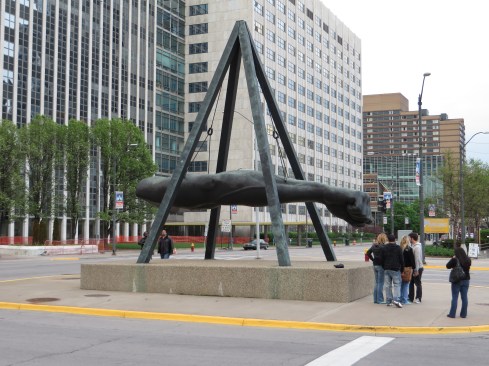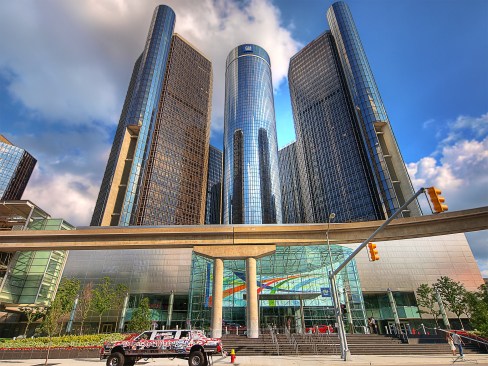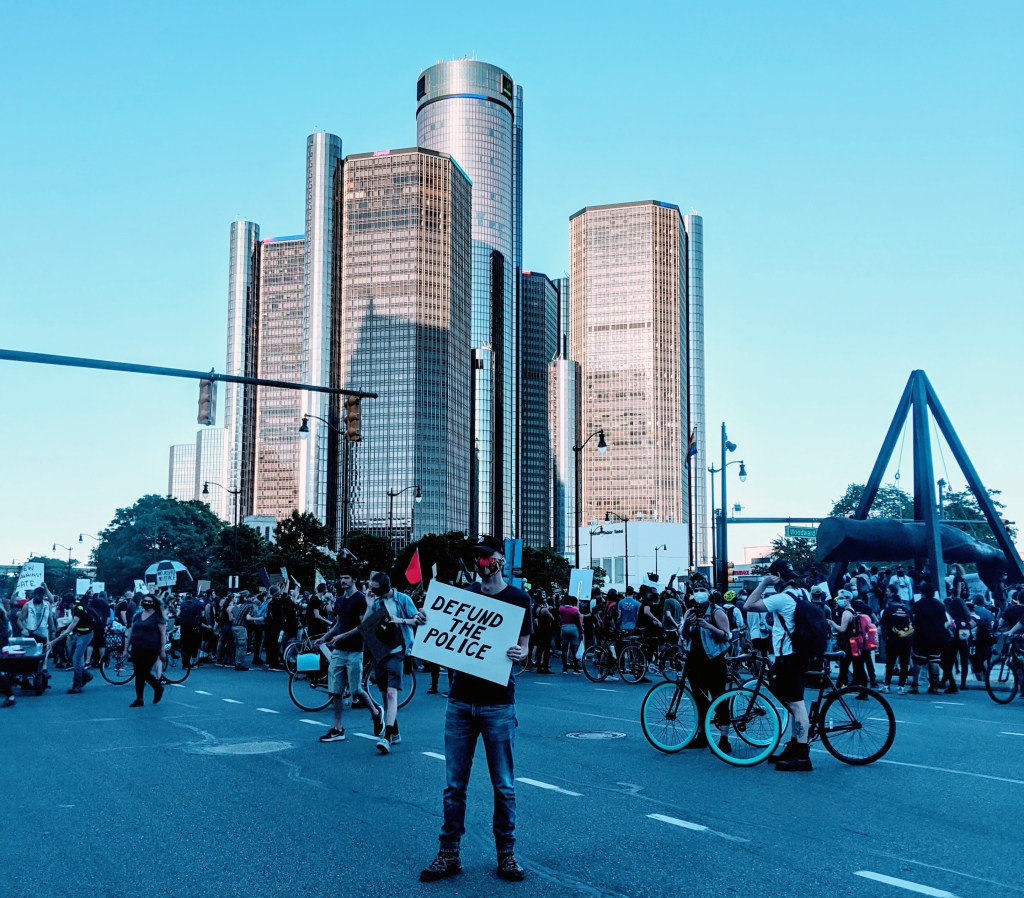A friend, the graphic designer Erik Adigard, recently pointed me to one of the more poignant images from the wave of civil unrest sweeping our country: a protester holding up a “Defund the Police” sign in front of the Renaissance Center in Detroit. All around him, people are milling about, many of them with bicycles, showing little concern for the traffic patterns of what is normally a major intersection. A street sign marks one of the roads as being Woodward Avenue, which cuts all the way from the lakeside to the city’s far suburbs. To the right you can see The Fist, Robert Graham’s 24-foot-long work of art inspired by the arm of boxer Joe Louis.
What struck me about this photograph, taken by Laura Walker, AIA, an associate at SmithGroup, and published with her recent Architect’s Newspaper op-ed, How Can Architects Promote Black Liberation While Designing Police Stations?, was the confluence of symbolism. First, there is the sculpture. It is a memorial to a hero who fought discrimination inside and outside the ring. It is not some glorification of either a general or a slave owner. It is also a fragment, rather than a statue of the whole body. It hangs in the air as an emblem of pure power. It is a floating rebuke to how we think of art and architecture as rooted monuments.
Then there is the Renaissance Center, now rebranded as the GMRenCen. Built between 1971 and 1977, and designed by John Portman to include office space, a hotel, restaurants, clubs, and retail establishments, it was intended to be a “city within a city.” There was a reason for that: a few years earlier, Detroit had been engulfed by riots and protests. They were triggered by the assassinations of Martin Luther King Jr. and Robert Kennedy, but they also had roots in the city’s history of embedded racism.

Flickr/Creative Commons/Ken Lund
"The Fist," by Robert Graham
Henry Ford II, who commissioned the project, claimed that it would be a symbol of Detroit’s rebirth after that violence, but it was a peculiar one: located away from both the central business district and the city’s neighborhoods, it was (and is) an inward-turned Emerald City, sheathed in acres of reflective glass that mask the interior. The whole is protected by concrete parking garages that originally provided just one point of access from the street—an entrance that could easily be closed off in the case of new riots.
The Renaissance Center, home first to the Ford Corporation and now General Motors, as well as what was once the fanciest businessman’s club in town, was an act of corporate isolation. If it was a harbinger of the future, it was one where white men ran corporations that separated themselves from the communities that fed them, worked for them, and that they supposedly served.
That tactic proved less than successful. The center did not generate significant new development in the surrounding area and was itself never exactly bustling. It is now, despite a renovation in the early aughts that cost as much as the original development, a relic of a bygone era of urban renewal. It is also, as the photograph shows, an emblem of how increasingly useless buildings as objects have become. The Renaissance Center is just a backdrop. Nothing much happens there. The action is taking place in front, on the corner. The people aren’t confined to air-conditioned isolation but have taken over the streets.

Flickr/Creative Commons/Paul Bica
The Renaissance Center
Of course, such freedom cannot last—except that it should. Even near the peak of the last boom, which also marked a tentative revival of downtown Detroit, the center was just over half occupied, and most shops were empty. The focus in most of Detroit was not in creating new structures, but in the conversion of former places of business into lofts, apartments, hotels, clubs, and restaurants.
The same has been true in cities all across the country, and it makes me wonder why anybody is still building new office buildings. I think the pandemic and the civil unrest has pointed to an even larger issue, however: We need to think beyond such objects. They serve as incubators for the coronavirus, and even if we defeat this disease, another one will flourish in the petri dish of people crowded together in conditioned environments, forced to share the air, elevators, and toilets. Moreover, such projects are sinks of power and wealth. Owning and controlling them extracts power and wealth, and limits access to the same.
The pandemic has forced us to turn to the outdoors for any kind of public activity. Here at Virginia Tech, where I help to run the School of Architecture and Design, we are planning to have most of our face-to-face teaching take place outside, in covered or sheltered areas. When we meet each other now for coffee, drinks, or meals, we congregate on porches or in other outdoor areas. We try to avoid touching or using any devices, preferring contactless payment, gestures, or other forms of virtual interaction. This is the future. We will concentrate on conditioning areas and people, not objects. We will manipulate the forces and relations in our world virtually. We will grow to understand the fragility of our own body and the body social. We will design the commons, not the castle; the relation, not the object; and the social, not the individual.
I do not mean to paint an overly idealistic picture of the future. Power will still be contested and all the embedded systems that produce signature buildings and objects (without much in the way of real design) will remain. But if architects understand that they must work with and for the people who were pictured standing in front of the Renaissance Center, and must figure out how to break open the box and redesign the intersection where Joe Louis’s fist cuts through the air, then they will have a good sense of the task at hand.
Aaron Betsky is a regularly featured columnist whose views and conclusions are not necessarily those of ARCHITECT magazine nor of the American Institute of Architects.
